
The Tercentenary Jubilee of the Reigning House of Romanov
More news about the 400th Anniversary of the House of Romanov:
- Paul Kulikovsky, editor of the Romanov News in his 2013 January (#57) and February (#58) issues shares the latest happenings in Russia during the 400th Anniversary Celebrations. Contact: Editor.
- Exhibition entitled Quartercentenary of the House of Romanov is on view until June 30, 2013, in the Rare Book and Manuscript Department, Butler Library, Columbia University in New York City. It coincides with the Summer Institute on Russian émigrés supported by the National Endowment for the Humanities.
- To mark the 400th anniversary of the founding of the Romanov dynasty in 1613, Hillwood Estate, Museum and Gardens (Washington, DC) is presenting a special exhibition, Pageant of the Tsars: The Romanov Coronation Albums with the six albums created over the course of the family’s reign. (Details under Museum News).
- The Fabergé: Legacy of Imperial Russia venue at the Hong Kong Heritage Museum in China, later traveling to Japan, is part of the Romanov Anniversary events (Details under Exhibitions).
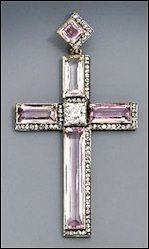
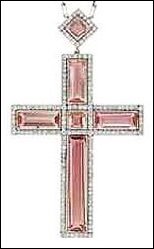
Asymmetrical Topaz Cross Pendants of
Grand Duchesses Xenia (left) and Olga Alexandrovich (right)
(Courtesy Christie’s)
April 15, 2013 Christie’s New York
Russian Works of Art Featuring Property from a Distinguished Midwest Private Collection
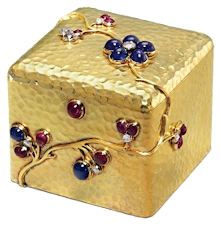
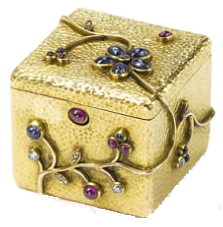
Jeweled Gold Boxes, ca. 1890 August Holmström (left)
and Similar Box by Eduard Wilhelm Schramm
(Courtesy: Christie’s New York and Bonhams London)
Carl Fabergé, of course, was known to have admired and collected Japanese works of art. Their influence, and that of the wider trend of Japonisme, can be seen in many works produced by the firm. This exquisite box is a perfect example. The hammered surface and blossoming tendril speak to the influence of Japanese metalworking techniques and decorative motifs. The use of a strong diagonal line, the sense of movement, and the use of negative space all speak to the influence of Japanese composition.
A similar box created by Eduard Wilhelm Schramm, a German by birth and a supplier to Fabergé specializing in hammered objects, was offered at auction. (Bonhams, London, November 24, 2008, Lot 170).
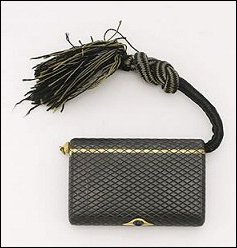
Gold-mounted Gun Metal Cigarette Case,
ca. 1900 (Courtesy Sotheby’s New York)
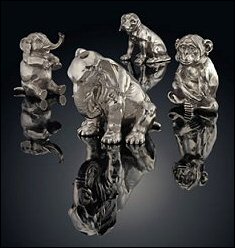
Silver Animal Sculptures by Fabergé
(Courtesy Christie’s London)
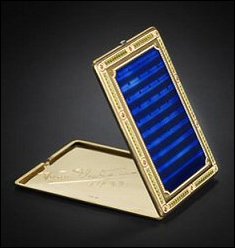
Cigarette Case Engraved ‘Victoria, 1933’,
Daughter (1868-1935) of Edward VII
and Sister of George V
(Courtesy Bonhams London)
Russian Works of Art, European Silver and Vertu
Family tradition holds the cigarette case (left above) served as the model for the ‘broad gun metal cigarette case’ surreptitiously slipped into James Bond 007’s left breast pocket as armor against a bullet in the movie From Russia with Love. Engraved 5 April 1982 and Listen … never … with anybody Provenance: Millicent Rogers, socialite, fashion icon, art collector, and heiress to the Standard Oil fortune.
June 3, 2013 Christie’s London
Russian Art
Auction includes a group of silver animals by Fabergé measuring less than 4½ in. (11.4 cm.) in height. The largest are an elephant and a monkey, the dog is a bell-push, and there are 3 lighters.
June 4, 2013 Sotheby’s London
Russian Works of Art and Fabergé
Rappoport clock given by Emperor Nicholas II at Tsarskoye Selo to Marie Félix Silvestre, a member of the delegation accompanying French President Emile Loubet to Russia during the historic State Visit of 1902.
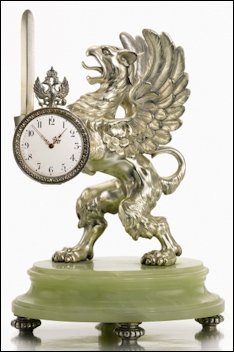
Imperial Presentation Fabergé
Silver and Bowenite Clock
(Courtesy Sotheby’s London)
The Russian Sale
The ‘Princess Victoria, 1933’ case was purchased for £155 on September 25, 1908, from the London Fabergé shop by Stanislaus Poklewski-Koziell, Councillor at the London Imperial Russian Embassy. The most expensive Fabergé flower study of a chrysanthemum purchased for £117 several months later by this same gentleman is today in The British Royal Collection.
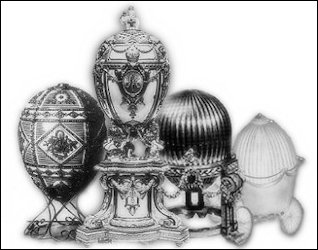
Four of Empress Marie Feodorovna’s Missing Eggs
(Photo Collage by Annemiek Wintraecken)
(Updates are posted in Exhibitions on the Fabergé Research Site)
Fabergé: A Brilliant Vision
A mini-book with the same title as the exhibition has been published. A catalog, From a Snowflake to an Iceberg: The McFerrin Collection, for the more than 350 objects is in preparation.
February 6 – April 29, 2013 Hong Kong Heritage Museum, China
Fabergé: Legacy of Imperial Russia
Four Fabergé Easter Eggs – 1891 Memory of Azov Egg, 1900 Trans- Siberian Egg, 1906 Moscow Kremlin Egg, and the unfinished Tsarevich Constellation Egg, and an additional 200 Russian and Fabergé objects are on loan from the Moscow Kremlin Museums and the Fersman Mineralogical Museum of Russia. The exhibition has traveled from Shanghai to Hong Kong, and will travel later to Japan.
Open until June 2, 2013 Bob Jones University Museum & Gallery at Heritage Green, Greenville, South Carolina
Rublev to Fabergé: The Journey of Russian Art and Culture to America
Five Fabergé objects from the Hillwood Museum, Estate and Gardens in Washington (DC), and the Middlebury College Museum of Art in Vermont are shown.
February 28 – June 2, 2013 Yale Center for British Art, New Haven, Connecticut
Edwardian Opulence: British Art at the Dawn of the Twentieth Century
Three bell pushes by Fabergé on loan from Buckingham Palace are included in the venue highlighting the reign of King Edward VII (1901-1910).
June 22 – September 29, 2013 Peabody Essex Museum, Salem, Massachusetts
Fabergé Revealed from the Collection of the Virginia Museum of Fine Arts
A traveling exhibition of over 230 objects from the Pratt Collection of the Virginia Museum of Fine Arts, recently shown in Detroit (Michigan), includes enameled clocks, gold cigarette cases, hardstone carvings, ruby encrusted brooches and four Fabergé eggs.
Open until December 2013 Cincinnati Art Museum, Ohio
The Bayard L. Kilgour & Kate Gray Kilgour Collection of Icons and Other Russian Objects
Seventeen objects from the St. Petersburg Fabergé workshops include a double bell push whimsically modeled as two elephants on a see-saw, a cameo box carved with a victorious scene of Alexander the Great, and a banker’s box with the cipher of Nicholas II, all by Henrik Wigström. The objects are part of The Collections: 6000 Years of Art exhibit at the museum. (Courtesy Gary Volz)
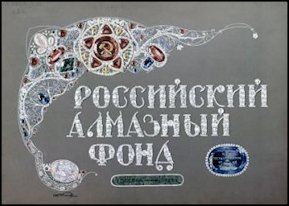
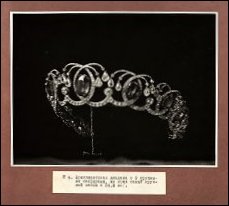
1922 Album Cover and Photograph of an Imperial Diadem, Not by Fabergé
(Courtesy USGS)
This diadem (or tiara) from above was not made by Fabergé because the future Empress Marie Feodorovna wore it at the wedding of Marie Alexandrovna (1853-1920) to Prince Alfred, Duke of Edinburgh (1844-1900), second son of Queen Victoria. Marie and Alfred married at the Winter Palace, St. Petersburg, on January 23, 1874, and Carl Fabergé had not yet started working for the Imperial Court. The sketch (below) by Nicholas Chevalier illustrates the diadem worn by Tsarevna Marie Feodorovna (born Dagmar of Denmark), wife of Tsesarevich Alexander III attending the wedding of Alexander III’s sister.

Study (detail) by Nicholas Chevailer of the Jewels Worn by the Tsarevna Dagmar in 1874
(Courtesy The Royal Collection)
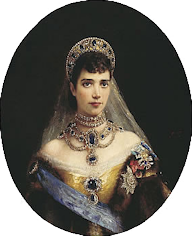
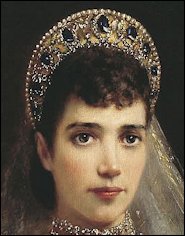
Empress Maria Feodorovna Wearing the Imperial Diadem
(Courtesy Wiki)
Christie’s London, March 16, 1927. Catalogue of an Important Assemblage of Magnificent Jewellery – Mostly Dating from the 18th Century, which Formed Part of The Russian State Jewels has been digitized by the USGS. (Courtesy of Jenna Nolt)
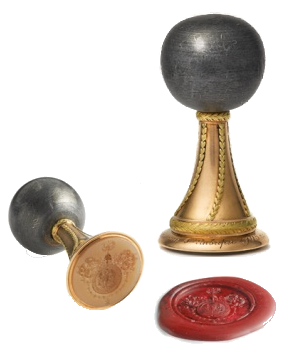
Fabergé Imperial Gold Hand Seal Surmounted by a
Single Spherical Lead Shot
(Courtesy Wartski)

Romanov Coronation Albums Exhibition
(Courtesy Hillwood Museum, Washington, DC)
Anthony Brandt’s article “Fab or Faux?” in Town & Country, November 2012, 126-29, 152-3, examines the million-dollar, buyer-beware realm of Fauxbergé. Beginning with a hands-on session at the Virginia Museum of Fine Arts the author learns about fakes and forgeries by interviewing authorities in the field of Fabergé.
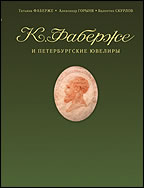
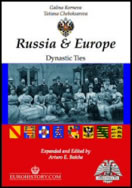
New Resources from Our Russian Contributors
The 2012 publication by the same three authors as the publication entitled Faberzhe I peterburgskie Juveliry (Fabergé and St. Petersburg Jewelers: Collection of Memoirs, Articles, Archival Documents on the History of Russian Art, 1997) is an update of the earlier volume. Major content categories are Fabergé Epoch in Russian Jewelry Art, St. Petersburg Jewellers, Research on the History of the Fabergé Firm, Jewellers of Petrograd-Leningrad, 1917-1990s, Contemporary History of the St. Petersburg Jewellers, 1991-2012, and an Appendix.
Korneva, Galina and Tatiana Cheboksarova, Russia and Europe – Dynastic Ties, 2013.
A new English edition with ca. 100 additional photos than the previous English and Russian editions explores the interrelationships through marriage between the German, Danish, Greek and Russian royal families with a strong focus on the Romanovs. Editor: Arturo E. Beéche.
Peregudova, Zinaida, et al. Dnebnik imperatora Nikolaia II, 1894-1918 in the series, Bumagi doma Romanovykh, 2011. In Russian.
Volume I covers the journals of Nicholas II for 1894-1904 and is “the first complete edition, unabridged with commentary and appendices – an expanded name index and detailed lists of military units in the diaries, operas heard by the Emperor, plays seen, books read, etc.” Volume II for the years 1905 to July 19, 1918, is in preparation.

‘… A remarkable group of Fabergé tiaras …
A photograph of three together is unprecedented…’
Geoffrey C. Munn
(Photograph Courtesy Wartski)
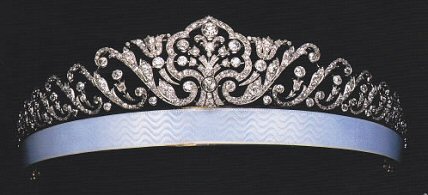
Fabergé Tiara by Fedor Afanasiev
(Courtesy Albion Art Company, Ltd.; Wartski, Fabergé and the
Russian Jewellers, A Loan Exhibition, 2006, 95 and 102, item 274)
The Myrtle Spray Tiara with stalks of engraved red gold and pierced leaves to suggest veining was purchased for the wedding of Hugh William Grosvenor and Lady Mabel Florence Crichton on April 21, 1906. (Wartski, ibid., 95 and 98, item 262), and worn again in modern times by Lady Tamara Grosvenor, the oldest daughter of the Duke and Duchess of Westminster.
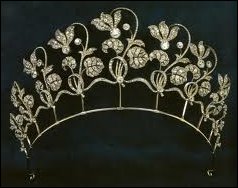
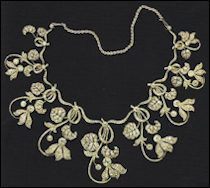
Cyclamen Tiara (ca. 1905-06) Becomes a Necklace When Detached from Its Base
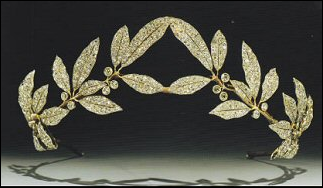
Myrtle Spray Tiara (ca. 1906) by Albert Holmström
(Courtesy Duke and Duchess of Westminster Collection)

Tiara with Forget-me-nots and Stylized Laurels, ca. 1900-03
(Munn, ibid., 302; Wartski, ibid., 87 and 94, item 249, Private Collection)

‘Empress Josephine Tiara’
by August Holmström, 1895.
(Courtesy McFerrin Collection;
Fabergé Research Newsletter, Winter 2009-10)

Cockerel Salt with Garnet Eyes
(Courtesy Taubman Museum of Art)

Cockerel and Hen Salt Cellars
(von Habsburg, Fabergé, 2000, 111,
Private Collection)
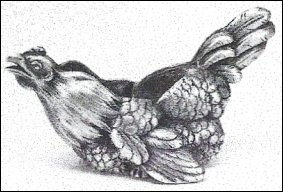
Hen Salt Cellar
(Courtesy Christie’s New York)
Fabergé Urn at the New York Stock Exchange by Christel Ludewig McCanless

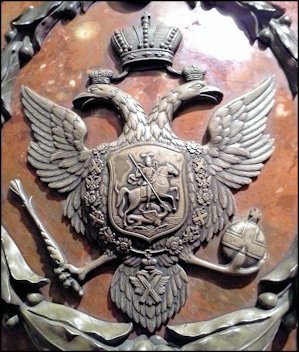
Jim Hurtt with the Fabergé Urn and the Silver Eagle Detail, Board Room, New York Stock Exchange
(Photographs Christel McCanless)
Jim Hurtt, a newsletter contributor, and I had the privilege of seeing a massive red Siberian jasper urn on a Siberian green jasper pedestal decorated with an oversized Romanov eagle, festoons, and an inscribed plaque, all in silver and with the Julius Rappoport ![]() mark in two places. Dimensions: Total height (87”), height of urn (40”), base (24” diameter), urn (20” across at widest point). The location of this impressive object is in the Board Room of the New York Stock Exchange (NYSE), which unfortunately is not open to the public. Our hosts were Director of the Archives Steven Wheeler and Archivist Janet Linde, and the tour included a review of the clipping files associated with the urn. Wheeler’s summary of the urn appeared on December 3, 2012, in celebration of Russia Day at the NYSE. The Fabergé design sketch for the urn and some of the history of the urn were published in the Fabergé Research Newsletter, Winter 2010-11. The article, “Old Russian Debt Still Repudiated – Statements by Khrushchev are Termed at Odds with Soviet Policy on Bonds”, in the New York Times (Sec. 3, Financial, September 13, 1959) updates the story of the $1 billion loan made to Russia by a group of New York banks to build a national railway system in Russia and of the Fabergé urn given to the exchange as an expression of gratitude for its role in raising the funds.
mark in two places. Dimensions: Total height (87”), height of urn (40”), base (24” diameter), urn (20” across at widest point). The location of this impressive object is in the Board Room of the New York Stock Exchange (NYSE), which unfortunately is not open to the public. Our hosts were Director of the Archives Steven Wheeler and Archivist Janet Linde, and the tour included a review of the clipping files associated with the urn. Wheeler’s summary of the urn appeared on December 3, 2012, in celebration of Russia Day at the NYSE. The Fabergé design sketch for the urn and some of the history of the urn were published in the Fabergé Research Newsletter, Winter 2010-11. The article, “Old Russian Debt Still Repudiated – Statements by Khrushchev are Termed at Odds with Soviet Policy on Bonds”, in the New York Times (Sec. 3, Financial, September 13, 1959) updates the story of the $1 billion loan made to Russia by a group of New York banks to build a national railway system in Russia and of the Fabergé urn given to the exchange as an expression of gratitude for its role in raising the funds.
Our visual inspection and the reading of New York newspaper articles published the day after the presentation confirmed two different colors of Siberian jasper were the materials of choice by the Fabergé workshop and proved that the pedestal was not fashioned from malachite, as has frequently been suggested over the years since the gift was unveiled on June 21, 1904.
